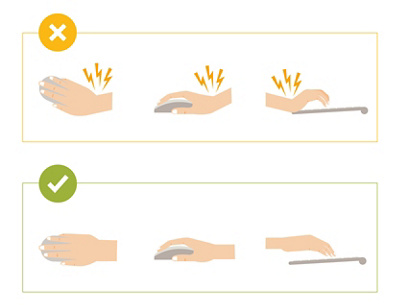The carpal tunnel is a passageway to the muscles and nerve that run along the inside of the wrist. When the median nerve in the wrist becomes compressed in this tunnel, this causes the condition known as carpal tunnel syndrome.
Causes
The median nerve and various tendons run along the inside of the wrist (carpus) through the carpal tunnel. There are a number of reasons why the carpal tunnel may become compressed and exert pressure on the median nerve.
Often, inflammation of the flexor tendons caused by increased usage is responsible for the development of the carpal tunnel syndrome. For example, frequent typing on a computer keyboard is a common everyday activity that can cause inflammation in the tendons in the wrist.
Other possible causes include swelling after injuries or a broken wrist, or rheumatic diseases. However, very often the syndrome develops for no discernible reason. Overall, it affects women more frequently than men. This is thought to be due to hormonal differences.
Symptoms
The pressure exerted on the median nerve causes sensory disorders in the hand and fingers such as a tingling sensation or numbness. Hand pain and sensory disorders are typical symptoms of carpal tunnel syndrome. They manifest as a tingling sensation, pins and needles, numbness or loss of feeling in the fingertips. Such disorders are sometimes accompanied by burning pains that can extend all the way down the arm. The symptoms are typically worse at night or when the hand stays in the same position for long periods of time.
Diagnosis
Carpal tunnel syndrome is diagnosed on the basis of its characteristic symptoms and through the use of special examinations. They include testing the hand’s nerve function (electroneurography) and muscle function (electromyography) by stimulating the nerves and muscles with electrodes. An ultrasound examination can be used to identify compression of the carpal tunnel.
Conservative treatment
The condition can be treated using conservative and surgical measures. Carpal tunnel syndrome is generally treated conservatively in the first instance. The wrist is immobilised using a brace or bandage. At the same time, the inflammation of the flexor tendons is treated with anti-inflammatory medication or local injections of cortisone. The earlier the conservative treatment is started, the better the chances of recovery. So it is important to have any problems promptly checked out by a doctor.
Surgical treatment
If conservative treatments do not fully resolve the symptoms, it is usually necessary to have an operation. This is usually performed on an outpatient basis. During surgery, the carpal tunnel is opened and the pressure on the nerves is manually relieved. This can also be carried out using a minimally invasive technique involving an endoscopy.
Why choose Hirslanden
The specialists at Hirslanden, the largest private hospital group in Switzerland, are renowned for their expertise and many years of experience in treating your illness.
You can expect comfortable rooms and a modern infrastructure as well as the highest standards in medicine and care.
We will help you throughout your entire stay, organising additional services such as translators and interpreters, transport, and overnight hotel stays for you and your relatives, and addressing all your administrative questions.
A personal contact from the Hirslanden International team will take care of your needs from the time that you first contact us to arrange an appointment through to the end of your treatment.
Contact us – we are happy to help you!

